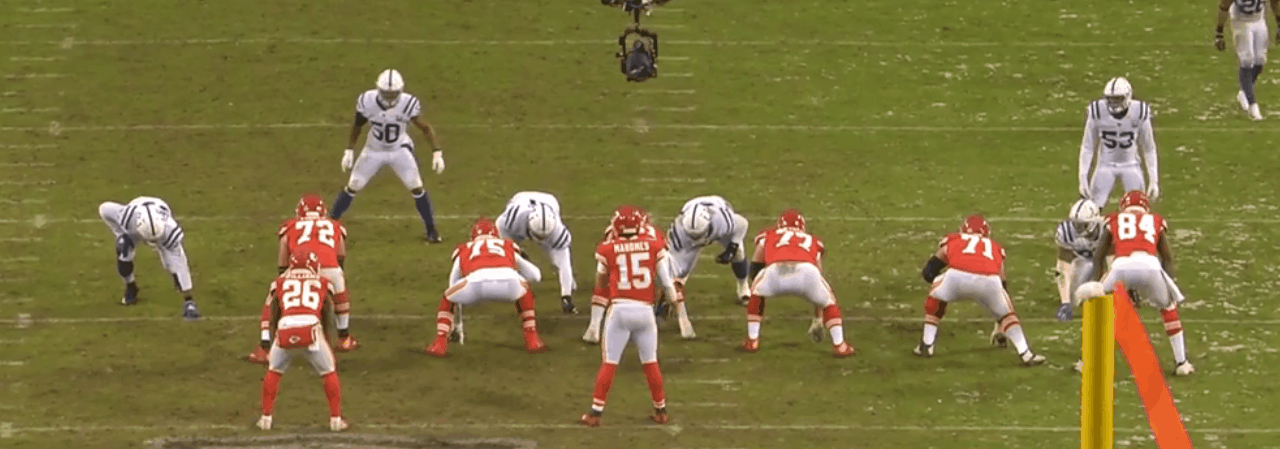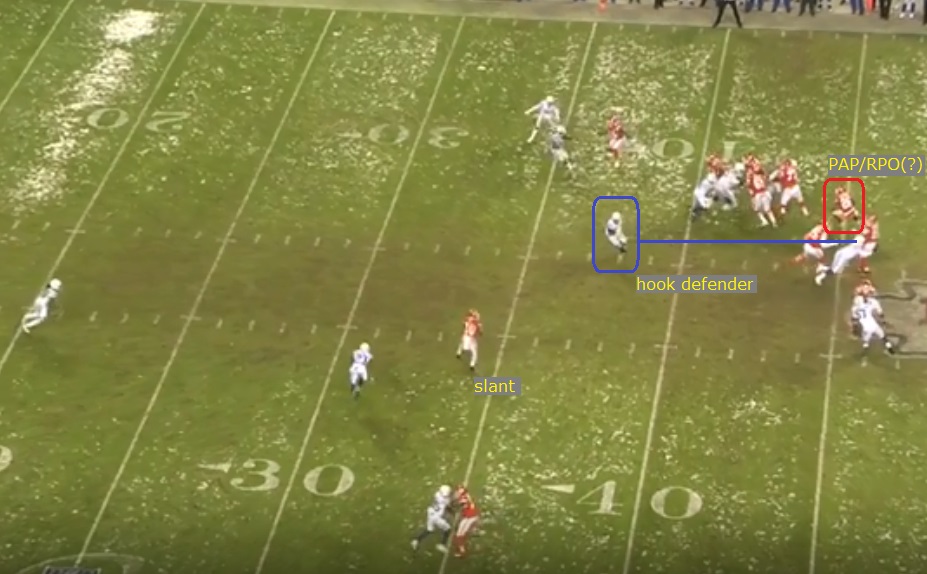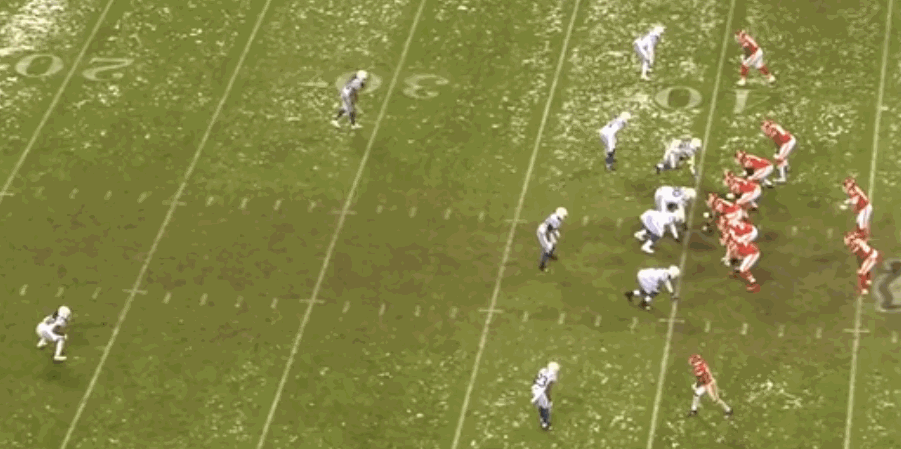Second Quarter, time: 5:02, situation: 2nd & 5, field position: IND 40.
No matter if the defence is in Cover 3 or in any sort of 2-high coverage, defending the hook zone is vital. Obviously, most NFL defences follow the bend-don’t-break principle, which means preventing a bomb
is their primary objective. The short passing game might, however, be as dangerous as breath-taking 40-yard passes. It’s a question of right personnel, but this is the NFL, not a European 2nd. Division;
this league is full of athletic tight ends or super-agile slot receivers who can accelerate, separate, catch and then run for extra 2-3 yards after contact. If the inside linebacker is overaggressive or
follows the running back in play action/RPO, the window of opportunity in the middle of the field suddenly becomes wide open.
There are tons of analyses stating how great Patrick Mahomes is. Fair enough, he’s by far the smartest young NFL quarterback I’ve seen in years. He is the MVP, and if a (retired) defensive coach says it
when the second contestant is an interior DLineman who just recorded 20.5 sacks, it means the QB really is brilliant. But this piece is not about him, it’s about covering the hook. Or rather not covering it.
The ball is on Indiana’s 40 yard line, still a rather safe distance to the end zone. Second down and 5 yards to go. A high probability of a run. The defence gives the offence a familiar look: 4 down
linemen, 2-high safeties, 2 linebackers. In the picture below, we see the pre-snap alignment. Darius Leonard drifts slowly towards the line of scrimmage. A blitz is coming. Anthony Walker mirrors Damien
Williams. There’s also movement in the secondaries, as Clayton Geathers gets closer to the wide receiver. He positions himself perfectly in order to prevent the slant. Indeed, the tight end picks up the
blitzing linebacker, there’s two-on-one to the left, no chance for the receiver to complete the pass.


The Chiefs didn’t want to pass to Geathers’ side, though. A play action fake caught Walker’s attention. The linebacker had mirrored Williams prior to the snap and kept mirroring him after the snap.
In the picture below, you can spot him changing direction and sprinting back to the hook.

To his right, Tyreek Hill just ran a slant route. Acceleration, separation, catch. The ball travelled in the air for 7 yards (from the LoS or 12 yards from the spot Mahomes threw it) before Hill caught the
pass and added 7 more yards on the ground. A well-designed play that targeted the apparently unimportant hook zone. The gifs below present the play from different angles.

Now, to numbers. In the first half alone, 26% of all passes where thrown to the receivers in the hook zone (actually, one pass was the shovel pass. Still a pass, though). Deep zones were utilised 8 times
(29.6%), but the longest throw Patrick Mahomes made was a 16-yard pass (that is the ball travelled 16 yards in the air). The table below presents the zone frequencies split according to the number of safeties
(1H – single-high, 2H – two-high).
| Zone: |
Incomplete |
Complete |
|
1H |
2H |
1H |
2H |
| Hook | 0 | 1 | 2 | 7 |
| Curl | 2 | 2 | 2 | 9 |
| Flat | 2 | 0 | 2 | 0 |
| Deep Right | 1 | 2 | 0 | 1 |
| Deep Middle | 1 | 2 | 2 | 1 |
| Deep Left | 1 | 0 | 0 | 0 |
| TOTAL | 7 | 7 | 8 | 18 |
Interestingly, the hook zone was not covered in 22 passing plays (51%). That’s a frequency that couldn’t go unnoticed. Leaving the hook empty seems to be alarmingly ineffective, especially when a defence
faces a superior tight end and/or slot receiver. To defences’ defence, this is how the bend-don’t-break principle works in practice. Defensive co-ordinators are more preoccupied with preventing the bomb rather than
preventing from moving the chains. Dropping inside linebackers to the deep middle is the cost defences pay for neutralising the deep pass threat. It may work well against four wide-outs, but it doesn’t against more
patient offence. Also, much has been written about Tampa 2 and its flaws. I’m not saying what the Colts played was the same, but it reminded me of this once great defensive concept. Back in the days, the seam route
was successfully utilised against the Tampa 2 defence. The routes that led to passing the football to the hook zone receivers in the Chiefs-Colts divisional play-offs were post, 6-in, hitch, and slant. (Oh yeah, and a
shovel pass).
Did down and distance affect the choice of the hook zone? I don’t think that was the case in the ‘standard’ situations with the distance not greater than 10 yards. Mahomes passed the ball to the receiver in the hook
four times in the first-down situation, and three times each in the second-down and third-down situation. The latter included two successful third-down conversions (Hill for 10 yards and Kelce for 7 yards).
Patrick Mahomes has just been named the MVP. Congratulations on a well-deserved honour. If the defences want to make his life a little bit more difficult, covering the hook seems to be a good start.



